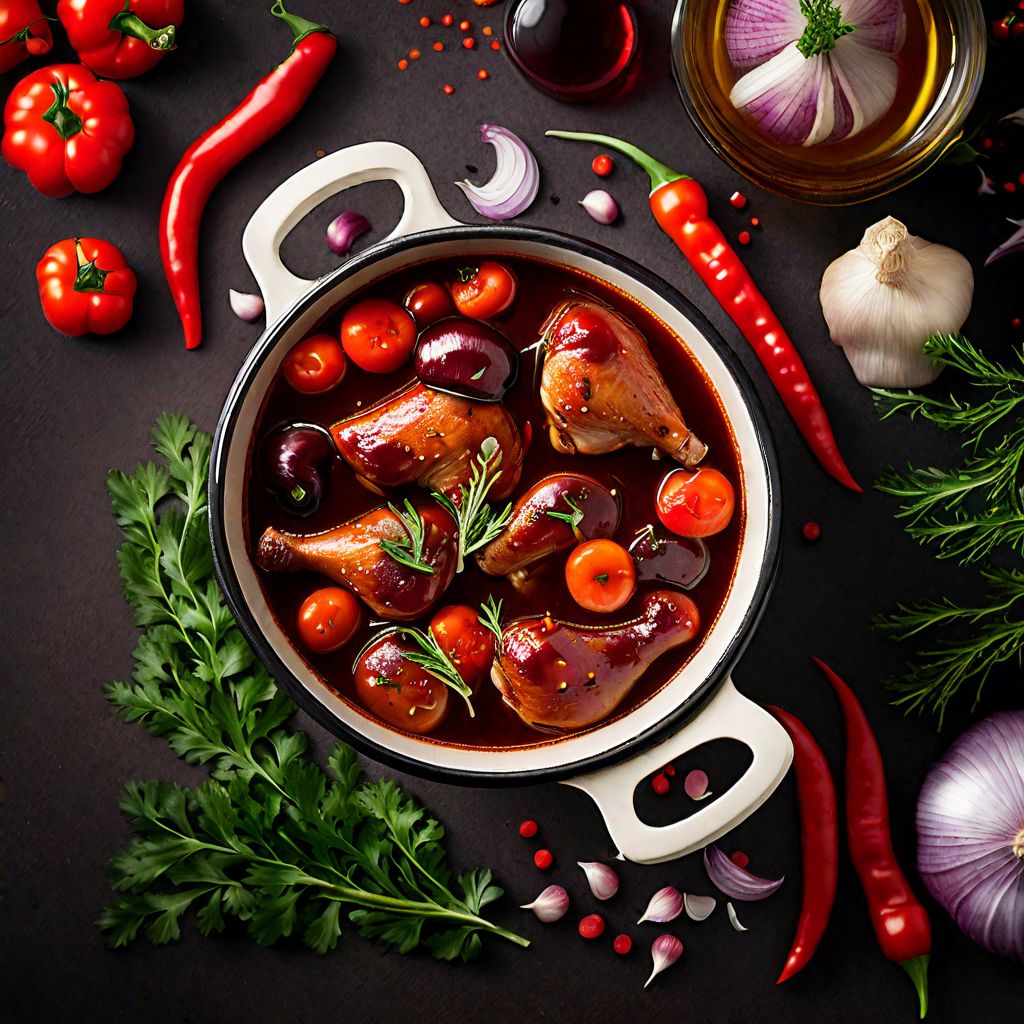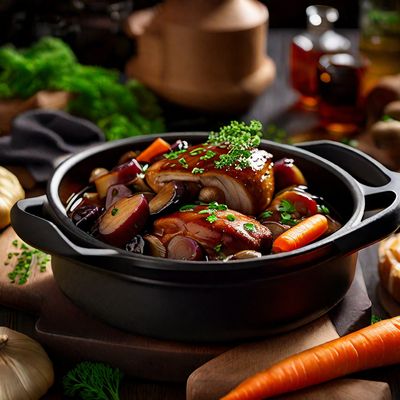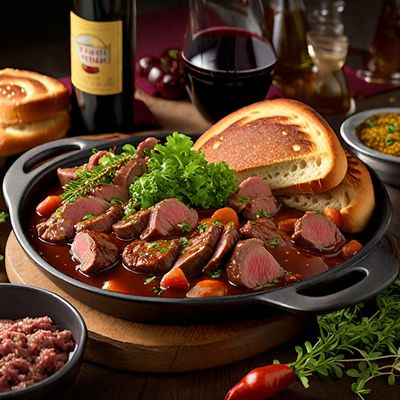
Recipe
Hungarian-style Coq au Vin
Paprika-infused Coq au Vin: A Hungarian Twist on a French Classic
4.8 out of 5
In Hungarian cuisine, hearty stews and rich flavors are highly valued. This Hungarian-style Coq au Vin recipe takes inspiration from the traditional French dish and adds a touch of Hungarian flair. The combination of tender chicken, smoky paprika, and robust red wine creates a comforting and flavorful meal that will transport you to the heart of Hungary.
Metadata
Preparation time
20 minutes
Cooking time
1.5 to 2 hours
Total time
1 hour and 50 minutes to 2 hours and 20 minutes
Yields
4 servings
Preparation difficulty
Medium
Suitable for
Omnivore, Gluten-free, Dairy-free, Low-carb, Paleo
Allergens
N/A
Not suitable for
Vegan, Vegetarian, Pescatarian, Nut-free, Egg-free
Ingredients
While the French Coq au Vin typically uses Burgundy wine and thyme, this Hungarian adaptation incorporates Hungarian red wine and paprika, which are essential ingredients in Hungarian cooking. The addition of paprika gives the dish a distinct smoky flavor and vibrant red color, while the Hungarian red wine adds a unique depth of flavor. This adaptation also includes traditional Hungarian spices and herbs to enhance the dish's authenticity. We alse have the original recipe for Coq au vin, so you can check it out.
-
1.5 kg (3.3 lbs) chicken, cut into pieces 1.5 kg (3.3 lbs) chicken, cut into pieces
-
2 tablespoons vegetable oil 2 tablespoons vegetable oil
-
2 onions, finely chopped 2 onions, finely chopped
-
3 cloves of garlic, minced 3 cloves of garlic, minced
-
2 tablespoons sweet Hungarian paprika 2 tablespoons sweet Hungarian paprika
-
1 teaspoon hot Hungarian paprika (optional for extra heat) 1 teaspoon hot Hungarian paprika (optional for extra heat)
-
250 ml (1 cup) Hungarian red wine 250 ml (1 cup) Hungarian red wine
-
400 g (14 oz) canned diced tomatoes 400 g (14 oz) canned diced tomatoes
-
250 ml (1 cup) chicken broth 250 ml (1 cup) chicken broth
-
2 bay leaves 2 bay leaves
-
1 teaspoon caraway seeds 1 teaspoon caraway seeds
-
Salt and pepper, to taste Salt and pepper, to taste
-
Chopped fresh parsley, for garnish Chopped fresh parsley, for garnish
Nutrition
- Calories (kcal / KJ): 450 kcal / 1880 KJ
- Fat (total, saturated): 25g, 6g
- Carbohydrates (total, sugars): 10g, 5g
- Protein: 45g
- Fiber: 3g
- Salt: 1.5g
Preparation
-
1.Heat the vegetable oil in a large pot or Dutch oven over medium heat.
-
2.Add the chopped onions and minced garlic to the pot and sauté until they become translucent.
-
3.Add the chicken pieces to the pot and brown them on all sides.
-
4.Sprinkle the sweet Hungarian paprika and hot Hungarian paprika (if using) over the chicken, onions, and garlic. Stir well to coat the ingredients evenly.
-
5.Pour in the Hungarian red wine and let it simmer for a few minutes to reduce slightly.
-
6.Add the canned diced tomatoes, chicken broth, bay leaves, and caraway seeds to the pot. Season with salt and pepper to taste.
-
7.Bring the mixture to a boil, then reduce the heat to low. Cover the pot and let it simmer for about 1.5 to 2 hours, or until the chicken is tender and the flavors have melded together.
-
8.Remove the bay leaves from the pot before serving.
-
9.Garnish with chopped fresh parsley and serve hot.
Treat your ingredients with care...
- Chicken — For the best flavor and tenderness, use bone-in, skin-on chicken pieces such as thighs and drumsticks.
- Hungarian red wine — Choose a full-bodied Hungarian red wine, such as Egri Bikavér (Bull's Blood) or Kadarka, to enhance the authentic Hungarian flavors of the dish.
- Hungarian paprika — Opt for high-quality Hungarian paprika for its distinct smoky flavor. Look for "Noble Sweet" or "Noble Sweet Delicate" paprika varieties for this recipe.
- Caraway seeds — Toast the caraway seeds in a dry skillet for a few minutes before adding them to the dish to enhance their aroma and flavor.
- Canned diced tomatoes — If you prefer a smoother sauce, you can use tomato puree instead of diced tomatoes.
Tips & Tricks
- For a richer flavor, marinate the chicken in the Hungarian red wine and paprika mixture for a few hours or overnight before cooking.
- Serve the Hungarian-style Coq au Vin with traditional Hungarian side dishes like nokedli (Hungarian dumplings) or tarhonya (Hungarian pasta).
- If you prefer a thicker sauce, you can mix a tablespoon of flour with a little water and stir it into the dish during the last 10 minutes of cooking.
- Leftovers can be refrigerated and enjoyed the next day, as the flavors tend to deepen and intensify.
Serving advice
Serve the Hungarian-style Coq au Vin hot, accompanied by a generous portion of nokedli (Hungarian dumplings) or tarhonya (Hungarian pasta). Garnish with freshly chopped parsley for a pop of color.
Presentation advice
Present the Hungarian-style Coq au Vin in a deep serving dish or individual plates. Arrange the chicken pieces on top of the sauce and sprinkle with additional paprika and parsley for an attractive presentation.
More recipes...
For Coq au vin » Browse all
For French cuisine » Browse all
More French cuisine dishes » Browse all

Lamprey à la Bordelaise
Lamprey in Bordeaux Sauce
Lamprey à la Bordelaise is a French dish that is made with lamprey eel.

Moules farcies
Stuffed Mussels
Moules farcies is a French dish made with stuffed mussels. It is a popular appetizer or snack in coastal regions of France.

Cinq centimes
Five Centimes
Cinq centimes are a type of French pastry that are typically made with puff pastry and almond cream. They are often enjoyed as a breakfast pastry...
More Hungarian cuisine dishes » Browse all

Sólet
Sólet is a traditional Jewish stew from Hungary. It is a flavorful and hearty dish that is perfect for cold weather.

Rákóczi túrós
Rákóczi Cheesecake
Rákóczi túrós is a Hungarian dessert that is made with quark cheese and a sweet pastry crust. It is a popular dessert in Hungary and is often...

Kalács
Kalács is a traditional Hungarian sweet bread that is often served as a dessert or snack. It is a soft and fluffy bread that is typically flavored...










